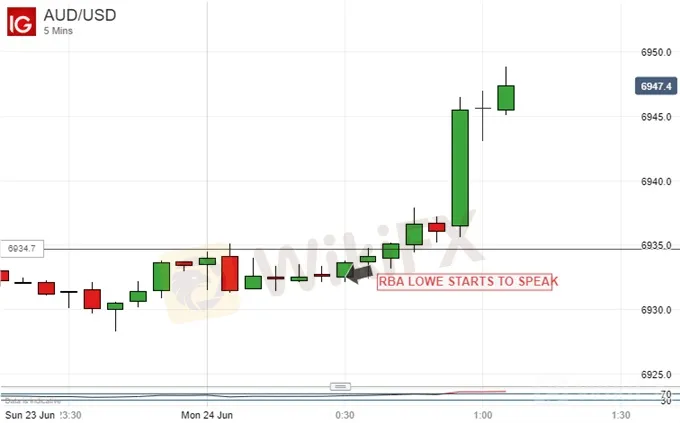简体中文
繁體中文
English
Pусский
日本語
ภาษาไทย
Tiếng Việt
Bahasa Indonesia
Español
हिन्दी
Filippiiniläinen
Français
Deutsch
Português
Türkçe
한국어
العربية
AUDUSD Gains, RBA Lowe Again Ponders Monetary Easings Limits
Abstract:The Australian Dollar got a lift after the RBA Governor pointed to some of the difficulties apparent in a world where everyone is lowering interest rates
Reserve Bank of Australia Governor Lowe, Canberra Panel Comments, Talking Points:
AUD/USD rose as Lowe spoke
He noted widespread economic gloom but pointed to the limitations of monetary policy
He also suggested more government stimulus in the shape of infrastructure spending
Join our analysts for live, interactive coverage of all major economic data at the DailyFX Webinars. Wed love to have you along.
The Australian Dollar rose Monday after Reserve Bank of Australia Governor Philip Lowe appeared once again to ponder the limits of monetary policys effectiveness.
Speaking on a panel in Canberra, Lowe noted that the global economy had slowed and that risks were to the downside still. However he said that it was ‘legitimate to ask’ how effective more monetary easing would be globally and that if everyone is easing, exchange rate effects are offset. In a nutshell cutting Australian rates won‘t help boost inflation by weakening the currency if rates head lower in Australia’s trading partners too.
Lowe also said that more infrastructure investment would benefit the Australian economy.
Australian interest rates were cut to a new record low this month, and futures market pricing suggests expectations that the easing process will continue.
The Australian Dollar gained after Lowe spoke, as he appeared to reinforce the message that the bar to deep rate cuts may very well be higher than the markets now think.

Central bankers around the world have largely kept monetary policy extremely accommodative since the end of the financial crisis. Clearly if long periods of record low interest rates have failed to spur pricing power, it is indeed legitimate to ask whether even lower rates would do the trick.
Lowe also flagged up European banks as a potential weak spot in the world economy. The Eurozone banking sector is fragmented and progress towards some sort of banking union has been glacial at best.
On its daily chart AUD/USD has bounced quite convincingly from its June lows but clearly remains under pressure. The long-term downtrend from early 2018 remains very much in place and the pair seems to be losing momentum before its previous significant peak.

The market clearly sees very little interest-rate support for the Aussie despite Lowes warnings that monetary policy cannot be the sole means of economic stimulus.
Disclaimer:
The views in this article only represent the author's personal views, and do not constitute investment advice on this platform. This platform does not guarantee the accuracy, completeness and timeliness of the information in the article, and will not be liable for any loss caused by the use of or reliance on the information in the article.
Read more

All Round Major Pairs Technical Analysis: EUR/USD, AUDUSD, And GBPUSD
The start of November has been a dwindling moment for the general major currency market. As essential economic updates flood the surface of the entire foreign exchange market, in which most of the currency pairs especially the major pairs were greatly affected by the impact of the economic releases. However, the US dollar was discovered to have held the main currency exchange performance metrics as the central economic updates from the US region tend to have determined the significant changes that have occurred in the major currency market so far.

Currencies wait for RBA to kick off big central bank week
The dollar hovered below recent highs on Tuesday as traders waited for the Reserve Bank of Australia to lead a handful of central bank meetings set to define the rates outlook this week.

US Dollar Holds Gains as Japan Boosts and China PMI Weighs. USD Volatility Ahead?
US DOLLAR, JAPAN ELECTION, USD/JPY, CHINA PMI, AUD/USD - TALKING POINTS

Australian Dollar Price Chart: AUD/USD Reversal Stalls– Trade Outlook
The Australian Dollar is up more than 2.6% on the back of a five-day rally with price eyeing initial resistance. These are the levels that matter on the AUD/USD charts.
WikiFX Broker
Latest News
ASIC Sues Binance Australia Derivatives for Misclassifying Retail Clients
Geopolitical Events: What They Are & Their Impact?
Top 10 Trading Indicators Every Forex Trader Should Know
WikiFX Review: Is FxPro Reliable?
Malaysian-Thai Fraud Syndicate Dismantled, Millions in Losses Reported
Trading frauds topped the list of scams in India- Report Reveals
Why Do You Feel Scared During Trade Execution?
Revolut Leads UK Neobanks in the Digital Banking Revolution
Fusion Markets: Safe Choice or Scam to Avoid?
SEC Approves Hashdex and Franklin Crypto ETFs on Nasdaq
Currency Calculator


